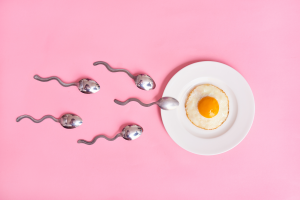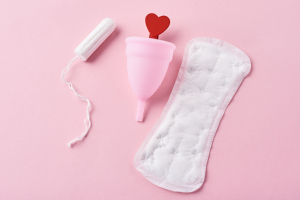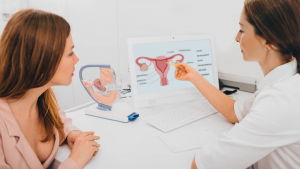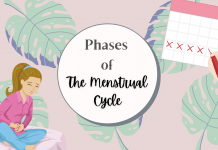If you’re at least 14, I’m pretty sure you have either experienced or thought about what the whole idea of “that time of the month” is about.
The menstrual cycle is a complex, coordinated sequence of events. It involves the hypothalamus, anterior pituitary, ovary, and endometrium.
The menstrual cycle having all its complexities can be easily influenced by environmental factors such as stress, extreme exercise, mood disorders, eating disorders, and obesity. However, we aren’t talking about any disorders here. In this article, we shall be focussing on what you, my fellow reader, should know about the menstrual cycle.
If there are any kind of changes in your body, there will be changes in your mood as well. Since there are a lot of hormones involved in the menstrual cycle, there are many effects it can have on you- both physically and emotionally.
So Basically…
The menstrual cycle is a monthly rhythmic cycle that prepares the uterus for pregnancy in females. Menstruation is usually referred to as the phase of the menstrual cycle in which the blood comes out of the vagina.
Why do people get their period?
The menstrual cycle is a monthly sequence of events that occurs in preparation of a possible pregnancy. The uterus has two ovaries that contain immature eggs. There are thousands of immature eggs present in there which start maturing when a person reaches puberty.

Each month one egg matures and gets released by one of the ovaries every month. These eggs are meant to get fertilized by a sperm and released into the fallopian tubes in order to meet with a sperm. This phase of the menstrual cycle is known as ovulation.
In case these eggs get fertilized by a sperm, then a zygote is formed. This zygote keeps undergoing cell division as it travels through the fallopian tube and gets implanted in the endometrial lining of the uterus.
In case the egg is not fertilized by a sperm, the egg along with the endometrial lining, degenerate and are released through the vagina mixed with blood. This marks the beginning of day 1 of the menstrual cycle. An average menstrual cycle is 28 days long but it can be anywhere between 21 to 35 days in length since we are all unique in our own ways.
The menstrual cycle can be divided into 4 phases- The menstrual phase, The follicular phase, Ovulation, Luteal phase.

The Menstrual Phase
This is the phase when there is menstrual bleeding. This phase begins from day 1 and can go up to day 6 in different people. The level of progesterone suddenly drops during this time. You might even feel low on energy. The endometrial lining of the uterus breaks down and flows out along with the blood.
The follicular phase
This phase begins around day 7 and goes up to day 14. The level of the Follicle Stimulating Hormone rises and causes the follicles in your ovary to mature. The egg is contained in these follicles. You might notice a white creamy discharge around this time. Since the testosterone and estrogen levels begin to increase, you might even feel more confident and have a higher sex drive (The uterus wants a baby after all!). The creamy discharge has an elastic consistency as it also has channels for the sperm to swim through.
Ovulatory phase
This phase is about 2-3 days long. Just before ovulation, your body undergoes an LH surge (another hormone). This LH or Luteinizing Hormone causes the follicle to burst open and the egg to release into the fallopian tube. This egg lasts for up to 24 hours. Since Estrogen and Testosterone are at their peak, you may look more attractive at this time and have distracting thoughts about having sexual intercourse.
Luteal Phase
This phase is the last phase of the menstrual cycle and can go up to day 28 of your cycle. After ovulation, the LH and FSH levels will sharply decline and estrogen and testosterone decline gradually. The level of progesterone rises as the egg starts producing more of the hormone. Since progesterone is a heat-producing hormone, it can also cause a rise in the basal body temperature. The vaginal discharge becomes sticky and loses its elasticity thus indicating that it is no longer fertile. This is followed by the menstrual phase.

You might experience something called Pre-Menstrual Syndrome during the Luteal Phase. PMS is a set of symptoms that occur right before your period. These symptoms include headaches, abdominal cramping, back pain, nausea, vomiting, diarrhea, or constipation and can vary from person to person.
Now, we know that people get their period when the egg formed by the ovary does not fuse with a sperm. How simple right? The presence of a period is seen as the indicator that a pregnancy has not occurred. While it can be a sigh of relief for someone who does not wish to get pregnant, it can be disheartening for couples who wish to conceive.
The absence of a period can be viewed as an indicator of a possible pregnancy. However, people can have a missed period due to other reasons ranging from simple reasons like stress, low body weight, obesity, etc., to underlying health conditions like PCOS, and certain cancers (very rare).
Who gets their period?
Now according to traditional ideas based on gender, all women of childbearing age get their period upon reaching puberty. This definition only confines the term menstruation to cis-gender women.
“Not everyone who menstruates identifies themselves as a girl or woman. Genderqueer folks and Transgender men possessing uteruses, vaginas, fallopian tubes, and ovaries also get their periods. However, their experience can be more stressful even though the process is scientifically the same.”
Now, not everyone who gets their period is a woman. Not everyone who is a woman gets their menstrual cycle. Sounds confusing right?
Allow me to break this down for you-
Everyone who happens to have a uterus in their body is supposed to get a period regardless of the fact which gender you identify with.
If you are a trans or non-binary or non-conforming individual or have a health issue like gynecomastia, your experience with the menstrual cycle or menstruation might be a little different.
However, what we will be talking about here is what most people with a uterus experience in general. Here, we shall talk about what changes your body goes through during a menstrual cycle.
Okay cool, but when does menstruation begin?
If you’re someone who hasn’t had their period yet or someone who didn’t come into this world with a uterus installed in your body, I’m sure you must be wondering when does this cycle even begin.

If you recall, I talked about how the menstrual cycle happens in people who are born with a uterus and a vulva. The event in which a person gets their period for the first time, is called Menarche.
Now, menarche occurs upon reaching puberty and is considered as the signal of possible fertility. Even though menarche can occur at any age, it usually takes place at any age between 11 to 15. What I am talking about here, is the average range when a person gets a menstrual cycle. Menarche can occur at different ages for different people and can have an impact on health as well.
So, it is better to remember the age when you first get your period because believe me when I say that this is going to be your ob/gyn’s favourite question if you ever visit them for a period related issue.
How much blood does a person lose on their period?
Research shows that on an average a person loses 20-60 ml of blood per cycle. This is approximately 4 tablespoonfuls of blood. If the amount of blood loss you experience seems more the normal range, it is best to contact your ob/gyn.
Excessive bleeding, called menorrhagia is isn’t usually a cause of concern unless it causes interruption in your daily activities.
Hold Up, where does all that blood go?
Now all that flowing blood needs to go SOMEWHERE, right? Obviously, the blood coming out of someone’s genitals can easily stain their clothes (and that event is more common than you think it is).
Yes, that is right, your friend did not sit on ketchup, it is just the day one (or two) of their menstrual cycle so you can relax. To solve this issue, products different types of menstrual hygiene products are available in the market. These include- menstrual cups, tampons, and our good ol’ sanitary napkins.

Menstrual Cups
Menstrual cups are small, flexible funnel-shaped cups made of medical grade silicone used for blood collection. They can be inserted in the vagina to help collect period blood. They can be used up to 8 hours at a time and can be reused after washing. Though they are medically safe, and do not involve risks such as TSS (Toxic Shock Syndrome- a risk involved with tampons).
Tampons
Tampons are small cylinder-shaped menstrual products made of soft cotton to absorb menstrual blood. Like menstrual cups, they are placed in the vaginal canal, but instead of collecting, they soak up menstrual blood.
Tampons required to be changed every 4 to 5 hours in a day depending on your flow. It is essential to do so to avoid a serious medical condition called Toxic Shock Syndrome. Tampons can come with or without an applicator.
Sanitary Napkins
‘Sanitary Napkins’, also known as ‘Sanitary Pads’, or just ‘Pads’, are absorbent items that you can stick inside your underwear. Some of them have extra material called ‘wings’ on their sides that are folded over either edges of the underwear. Like tampons, pads need to be changed after every 5 to 6 hours. Usually, one pack is enough for one menstrual cycle.
Even though there are choices available in the market, most of you will have them chosen by your parent or guardian.
While there is nothing wrong with letting someone more experienced choose for you as all the above-mentioned menstrual products are safe and effective but sometimes you might need to look for alternatives for performing certain activities, like swimming. It is your cycle after all.
However, there is no such rule that you have to stick to the same old methods of blood collection selected by someone else. In some cultures, one might not be allowed to opt for a different method of blood collection, due to certain cultural practices.
For example, in some cultures, adolescent girls are not allowed to use tampons for blood collection. They believe that it would break their hymen and take away their “virginity”.
Even though on some occasions, a tampon may cause the hymen to stretch or tear, it lends to the idea that the hymen can be a measure of one’s virginity.
There is a whole lot of stigma attached to period itself but it all comes down to one thing- sexism (which is a whole lot of baloney).
When to see a doctor?
However unique your menstrual cycle or your situation may be, some symptoms can be common to everyone. As informed individuals, it is our own responsibility to take care of our health. You should see a doctor when-

- You are experiencing severe pelvic pain that is interrupting your daily routine.
- You have mid-cycle bleeding. That means if you notice any kind of bleeding in the middle of your cycle before your next period is due.
- You have not had a menstrual period in 3 months, even if you haven’t had unprotected sexual intercourse. Especially when you have not had unprotected sexual intercourse.
- You are experiencing heavy bleeding.
- If you have to change your pad or tampon more than four times a day, or if you have to empty your menstrual cup any more than thrice a day.
- If you have to use double protection- like a pad with a tampon/menstrual cup.
- You have spotting between your menstrual cycle or instead of your period.
- You have indulged in unprotected sexual intercourse and missed a period.
- Your menstrual cycle has been highly unpredictable.
- You have prolonged bleeding that lasts more than 7 days.
It is important to keep a track of your menstrual cycle and keep a check on your symptoms. There are many apps available for the same. If you observe any abnormality in your period, make sure you see a certified health professional.
If you liked “The Menstrual Cycle 101- All about period”, you might also want to read Top 7 myths about menstruation that will blow your mind! to find out how the idea of menstruation has been perceived by cultures and the beliefs that have developed over time.
To keep track of our latest posts, connect with us on Facebook.




